July-September 2019: Overview of Events during Quarter
This is the third of a series of quarterly reviews of major events related to international conflict and cooperation, summarizing major events in the news from the past three months. We focus on conflict and cooperation between countries that disagree over specific types of contentious issues, in order to track how countries choose to manage, escalate, or settle their disagreements. This draws from research by the Issue Correlates of War (ICOW) research project, which currently studies four types of contentious issues:
- Territorial Claims: explicit contention between the official representatives of at least two nation-states regarding sovereignty over a specific piece of territory. These might involve contention over land along the border between the two states (such as the claim between Israel and Syria over the Golan Heights), islands (such as the claim between Japan and Russia over the Kuril Islands/Northern Territories), or colonial/dependent territory far from one or both sides' homelands (such as the claim between Argentina and the UK over the Falkland/Malvinas Islands).
- River Claims: explicit contention between the official representatives of at least two nation-states regarding the use or abuse of a specific international river or river system shared by the two states. These might involve contention over the quantity of water crossing the border, the quality of water (due to pollution), navigation, or flooding; prominent examples include the claim between Egypt, Ethiopia, and Sudan over Ethiopia's Grand Renaissance Dam on the Blue Nile River and the claim between Bangladesh and India over sharing Teesta River waters.
- Maritime Claims: explicit contention between the official representatives of at least two nation-states regarding the use of a specific maritime zone. These might involve concerns over fishing, undersea resources such as oil, or navigation rights through the zone; prominent examples include the claim between Kenya and Somalia over the maritime border in the Indian Ocean and claims between a number of states over waters in the South China Sea.
- Identity Claims: explicit contention between the official representatives of at least two nation-states regarding the status of a shared ethnic group. These might involve demands for better treatment or autonomy for the group within the target state (such as Austrian demands over the rights of ethnic Germans in the former province of South Tyrol in Italy), independence of the group from the target state (such as the Turkish support for the Turkish Republic of Northern Cyprus against Cyprus), or irredentist demands for the transfer of the group from the target state to the challenger state making the demands (such as the Russian demand against Ukraine over the Crimean Peninsula in 2014).
Our quarterly review methodology page explains the process of searching for news related to each of these four issue types during this quarter, and describes the types of events that are identified for inclusion in this review. Please note that the ICOW project does not endorse or support any country's positions with respect to any of the claims in our data set. Our purpose is to provide an impartial compilation of data on territorial, river, maritime, and identity claims (as well as any other future data sets that we might collect) by using rigorous coding rules to identify cases where nation-states explicitly disagreed over specific issues. Where possible, we use the most common English-language names for disputed features or groups, supplemented with widely used names in other languages; the choice of which names to list or in which order does not imply any support for either state's position.
ICOW Site Search
This search interface allows you to search through these quarterly reviews for such terms as names of territories, countries, or leaders. (For now, this is limited to ICOW's quarterly reviews of news over territorial, river, maritime, or identity claims, covering events since the beginning of 2019. In the future, we plan to expand this search to include access to summary web pages for each of the more than 1200 claims identified by the ICOW project, which will be created as part of the next external grant that the ICOW project receives.)
New Claims
Only one new claim began during this quarter:
- Territorial claims: the United States made a brief attempt to acquire Greenland from Denmark. The claim does not appear to have lasted very long, possibly no more than several weeks -- but it was clearly official U.S. government policy while it lasted, leading to a worsening of relations between two formally allied states when Denmark rebuffed U.S. President Trump's overtures.
- River claims: (no new claims)
- Maritime claims: (no new claims)
- Identity claims: (no new claims)
Potential Claims
Another 59 cases had some elements of claims during the quarter and could potentially qualify as codable claims in the future. These potential claims generally failed to meet at least one of the requirements of the ICOW definition listed above, which requires explicit contention over a specific territory, river, maritime zone, or shared ethnic group by official government representatives who are authorized to make foreign policy:
27 potential territorial claims made news this quarter but did not meet the full ICOW definition:
- No official government actor: Five potential claims did not involve official foreign policymakers from two or more states. This included actions by cattle rustlers between Ethiopia and Kenya, a local official in Italy honoring a controversial historical figure, and local opinion polls suggesting support for Irish unification but no supporting statements by government officials; there were also two potential claims involving Palestine and the Turkish Republic of Northern Cyprus, neither of which is recognized as a nation-state.
- No explicit contention: There were 22 cases where outsiders speculated that a country might be seeking to claim territory, but there was no evidence of this. Examples include border violations by local officials or police or airspace violations that do not appear to be part of an explicit claim by the national government, unverified reports by media or private citizens, and questions over the demarcation of an agreed border (where they only question involves the placement of border markers on the ground, not the location of the border on maps).
Six potential river claims made news this quarter but did not meet the ICOW definition:
- No official government actor: Five potential claims involved complaints by or against local officials or private citizens; codable river claims require demands by and against the national governments of at least two nation-states.
- No explicit contention: There was one potential claim with the opening of a major dam project, but the explicit disagreement over the dam had been resolved the previous year.
Twelve potential maritime claims made news this quarter but did not meet the ICOW definition:
- No official government actor: In two cases, the contention involved private citizens who were not acting on the behalf of their governments, primarily by fishing in another state's waters that are not currently claimed by their home government.
- No explicit contention: There were eight cases that fell short on this count, ranging from disagreements over maritime pollution (which does not qualify as a maritime claim under our current coding rules) to freedom of navigation operations (where there is no disagreement over specific maritime zones) and concerns over innocent passage through another state's waters.
- Other reasons: two other potential cases failed to qualify because they concerned flight control zones or ADIZ zones rather than disagreements over maritime zones.
14 potential identity claims made news this quarter but failed to meet the ICOW definition:
- No official government actor: In six potential cases, there was no government actor making explicit demands over the treatment of the group in the other country. Any demands were only made by private citizens, and their government either declined to support them or explicitly disavowed their demands.
- No explicit contention: In four cases, there was no evidence of an explicit demand between two governments, where the potential challenger government did not make any explicit demands over treatment of a shared ethnic group (even if some observers speculated that there was a problem).
- No codable EPR/TEK group: four potential claims could not qualify because the EPR/TEK data set of ethnic groups does not identify the group as being politically relevant in both states (Abkhaz in Georgia, Crimean Tatars in Turkey, Rohingya in Bangladesh, Anglophones between Cameroon and Nigeria). The ICOW project relies on this widely used data set for our list of ethnic groups that could become involved in claims, rather than trying to construct our own list of groups from scratch, so any group that does not appear in this data set can not be included in our data.
Case Summaries:
Claim Escalation and Provocations
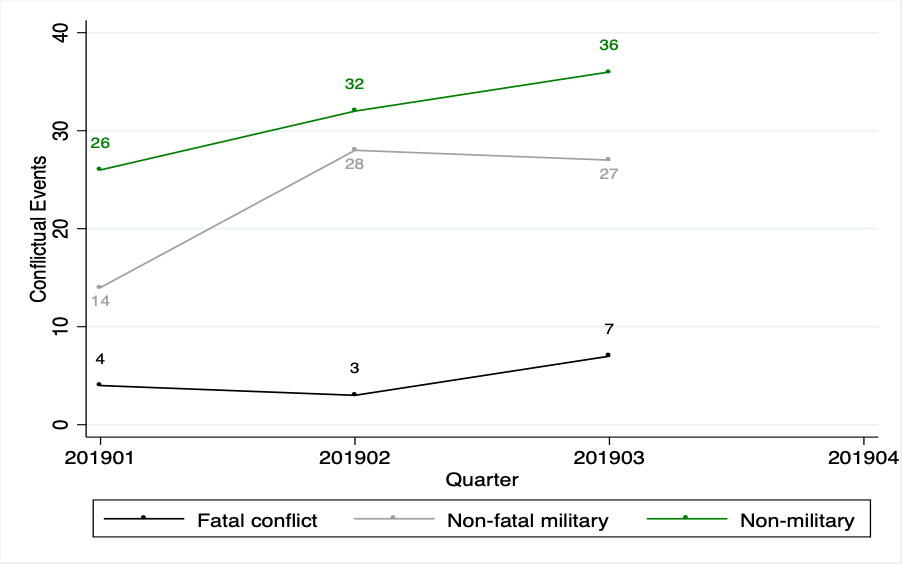
During this quarter, a total of 49 claims had at least one type of escalation or provocation, many of which had more than one type. Seven claims saw at least one claim-related fatality, 27 saw non-fatal military activity, and 36 saw non-military provocations. These numbers are up slightly from the previous quarter, which had three claims with fatalities, 28 with non-fatal military activity, and 32 with non-military provocations. Both the second and third quarters of 2019 saw substantially more conflictual activity than the first quarter (the first quarter for which we kept these records).
There was a great deal of continuity in escalatory behavior from the previous quarter to the present. Just over half of all claims with escalation this quarter also experienced at least one type of escalation in the previous quarter (25 of 49, or 51.0%), and more than half of claims with escalation in the previous quarter also experienced at least one type this quarter (25 of 46, or 54.3%). This general pattern held for all three broad categories of escalatory behavior; 6 of the 7 claims with fatal conflict this quarter (85.7%) also experienced escalatory behavior in the previous quarter, as did 17 of 26 with non-fatal military activity this quarter (65.4%) and 17 of 34 with non-military provocations (50.0%). This suggests that outside actors would do well to focus their attention on these states that are currently engaging in provocations or militarized conflict, because there is a very good chance that these same adversaries will continue to engage in risky behavior in the future.
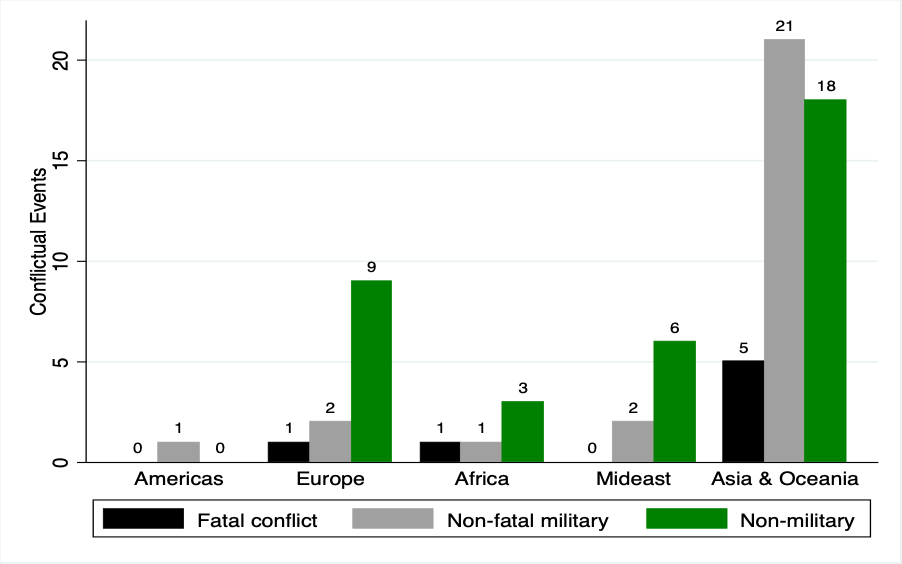
The majority of conflictual events occurred in claims in Asia and Oceania. Five of the seven claims that produced fatalities were located in Asia, as were 21 of the 27 claims with non-fatal military activity and 18 of the 36 claims with non-military provocations. These Asian cases came from all across the region, including eight claims in East Asia (one of which produced fatalities), four in Central Asia and the Caucasus (two with fatalities), eight in South Asia (three with fatalities), and eight in Southeast Asia and Oceania (none of them fatal). Europe saw twelve claims with provocations or military activity (one producing fatalities), followed by the Middle East (eight claims, none fatal), Africa (five claims, one fatal), and the Western Hemisphere (one claim, non-fatal). Asia led all regions in conflictual behavior in the two previous quarters as well, with 30 claims (three fatal) in the first quarter of the year and 34 (two fatal) in the second; no other region saw more than twelve claims with provocations of any type or one claim with fatalities in either of those quarters.
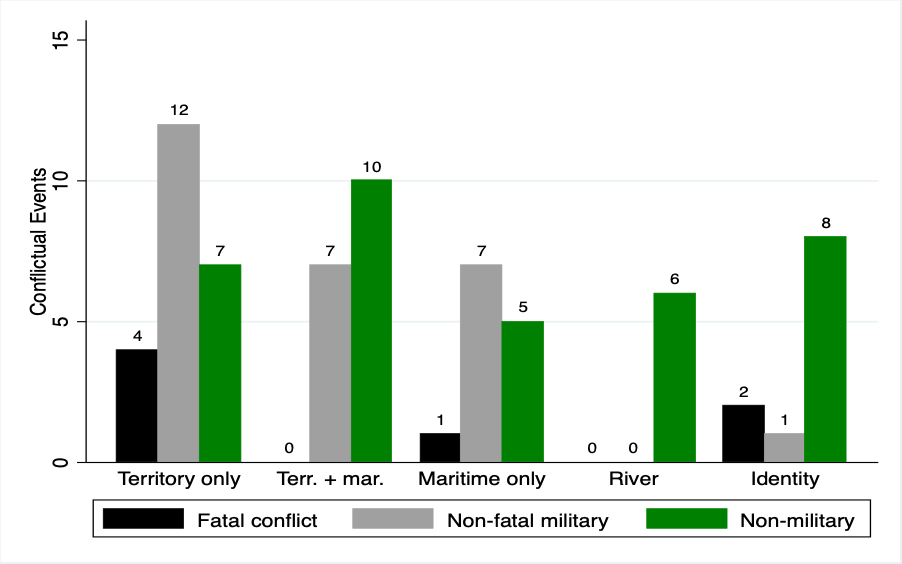
Turning to type of claim, more than half of the claims that experienced confrontational events in this quarter were territorial claims. Claims that were strictly territorial, typically involving land borders, accounted for four fatal conflicts, twelve non-fatal military activities, seven non-military provocations. Territorial claims that also include a maritime element, typically involving claims to islands with the associated maritime zones around them, included seven with non-fatal military activities and ten with non-military provocations, although none of these produced fatalities. Strictly maritime claims, where the states disagree over the use of the maritime zone for such purposes as fishing, oil or gas extraction, or navigation but there is no claim over territory above the sea, included one with a single fatality (a North Korea fisherman who was killed resisting arrest by Russian forces), seven with non-fatal military activity, and five with non-military provocations. Identity claims included two claims with fatalities, one with non-fatal military activity, and eight with non-military provocations, while river claims were the least conflictual with only six non-military provocations during the quarter.
- 7 claims with fatal conflicts: The bloodiest claim during this quarter was the identity claim between Russia and Ukraine over ethnic Russians in eastern Ukraine, which saw at least 48 military deaths among Ukrainian and separatist forces and five civilians during this quarter. The territorial claim between India and Pakistan over Kashmir was close behind, with at least 29 soldiers and 19 civilians dying during the quarter. The territorial claim between South Sudan and Sudan over Abyei led to the deaths of at least one peacekeeper and five civilians, the territorial claim between Kyrgyzstan and Tajikistan saw the deaths of at least four border guards and one civilian, the territorial claim between Afghanistan and Pakistan over the Durand Line killed at least six soldiers, one North Korean fisherman died resisting arrest in the maritime claim between North Korea and Russia over the Sea of Japan, and the identity claim between Armenia and Azerbaijan over Nagorno-Karabakh saw at least two military deaths in near-daily shooting.
- 27 with non-fatal military action: In eight territorial claims (one of which also has a maritime element) and three maritime claims, military, police, or coast guard personnel from one of the claimants harassed or arrested civilians from the other country. Most of these incidents involved interference with farming or herding near disputed borders or seizure of fishing boats in disputed waters. In eleven territorial claims (six of which also have a maritime element), four maritime claims, and one identity claim, military forces committed border violations or other provocations in disputed areas, often related to protecting the state's citizens engaged in fishing or oil exploration, or trying to intimidate the other state's citizens.
- 36 with non-military activity related to the claim: seven territorial claims (five of which also have a maritime element), two maritime claims, five river claims, and one identity claim saw at least one side announce or undertake actions in the disputed territory/river/maritime zone, such as construction or oil exploration in disputed areas. Ten territorial claims (five of which also have a maritime element), three maritime claims, one river claim, and seven identity claims were also the subject of verbal or other non-militarized provocations, typically involving threats or demands that were seen as a provocation by the other state.
Claim Escalation
As noted above, seven claims saw at least one claim-related fatality during this quarter, out of the 49 total claims that experienced at least one type of provocative event during the quarter. The greatest risk of escalation came in strictly territorial claims (with fatalities in four of sixteen claims) and identity claims (with fatalities in two of eight claims). The risk was lower with strictly maritime claims (with a single civilian fatality in one of nine claims), and there were no fatalities this quarter in the ten combined territorial and maritime claims or the six river claims that experienced provocations.
Non-fatal military activity during this quarter was far more common in territorial and maritime claims than in river or identity claims. Such activities -- whether border violations or actions against civilians in disputed areas -- occurred in a total of 26 of the 49 claims that experienced at least one provocative event. This included twelve strictly territorial claims, seven strictly maritime, and six claims with both territorial and maritime elements; none of the six river claims and only one of the eight identity claims saw such action. The remaining claims, mostly river and identity claims, remained limited to verbal and other non-military provocations during the quarter.
These results are consistent with past research on contentious issues, which has found that the risk of armed conflict -- particularly fatal conflict -- is greatest for territorial claims. Territorial claims are often considered the most "salient" or valuable type of contentious issue because they typically have both high tangible salience (referring to the physical attributes or contents of the disputed issue) and high intangible salience (referring to psychological ties or identification with the disputed issue). Maritime and river claims typically have relatively high tangible salience due to the physical value of the water, fisheries, or resources, but lower levels of intangible; identity claims typically have relatively high intangible salience due to ties with one's ethnic kin across the border, but lower levels of tangible. Data collection and analysis of identity claims is not yet complete, but past research has found river claims to have the lowest levels of armed conflict, while maritime claims fall between river and territorial claims in militarized conflict overall but with little risk of fatalities.
Case Summaries (detailed summaries of individual claims that were active this quarter):
Peaceful Claim Management and Settlement
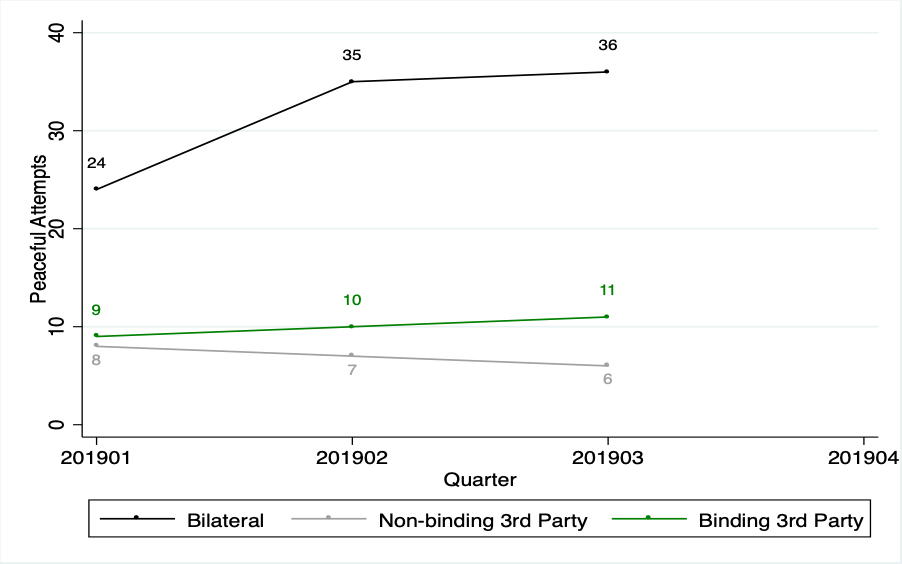
This quarter saw little change in peaceful conflict management efforts compared to the previous quarter. 36 claims saw bilateral negotiations between the claimants, compared to 35 in the previous quarter. Six claims experienced non-binding activities like mediation and eleven experienced binding activities like adjudication, compared to seven and ten in the previous quarter. Because a given claim could experience more than one type of settlement attempt, a total of 50 claims had at least one type of peaceful settlement attempt during the quarter, about the same as the 49 claims that had at least one type of escalation or provocation.
Half of the peaceful settlement attempts occurred in claims that also experienced provocations during the quarter (25 of 50), which is consistent with the expectation that escalation attracts conflict management. This is generally consistent with the results for each type of settlement attempt. 17 of the 36 claims with bilateral negotiations (47.2%) also had at least one type of provocation, suggesting that the claimants seek to deescalate or manage their problems before they can spiral out of control. Five of the six claims with non-binding third party activities (83.3%) also experienced at least one provocation, suggesting that third parties are even more concerned about limiting escalation. Even five of the eleven claims with ongoing binding third party activities (45.5%) experienced escalation or provocations during the quarter, although the protracted nature of most arbitration or adjudication processes suggests that these are less likely to be a reaction to events in the claim during this specific quarter.
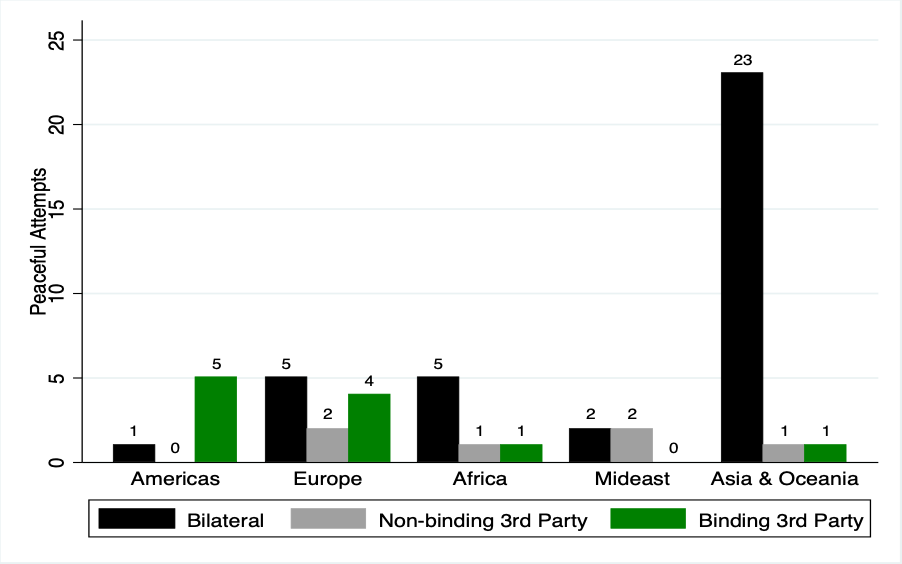
As with the provocations discussed above, the majority of peaceful settlement attempts during this quarter occurred in Asia -- 23 Asian claims saw bilateral negotiations, and one each saw non-binding and binding third party activities. These included three claims in East Asia, five in Central Asia and the Caucasus (including one with mediation), eight in South Asia (including one with an arbitral tribunal), and nine in Southeast Asia and Oceania. The second most active region was Europe, with five claims producing bilateral negotiations, two with non-binding activities, and four with binding activities. These were followed by Africa with a total of seven (one non-binding and one binding), the Americas with six (five binding), and the Middle East with four (two non-binding).
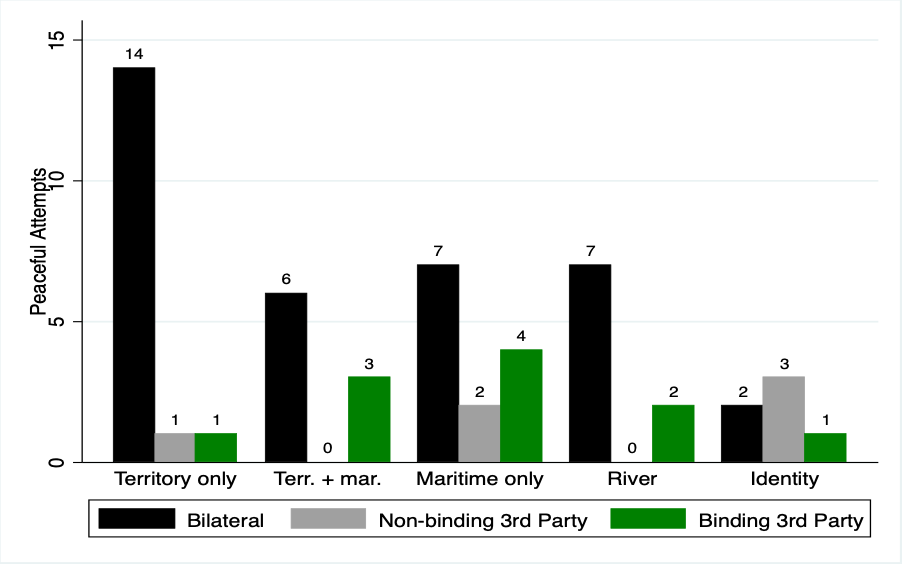
Territorial claims experienced more peaceful settlement attempts than any other type of issue. Sixteen exclusively territorial claims saw at least one type of peaceful settlement attempt during the quarter, as well as nine more with maritime elements. Eleven maritime claims saw peaceful management, as did nine river claims and five identity claims.
- 36 claims with bilateral negotiations: 14 exclusively territorial claims, six territorial claims with maritime elements, seven maritime claims, seven river claims, and two identity claims were managed through bilateral negotiations between the claimants during this quarter.
- Six with non-binding third party activities: one territorial claims, two maritime claims, and three identity claims were managed with the non-binding assistance of at least one third party. The mediators included the United States (over the Israel/Lebanon land border and the Israel/Lebanon maritime claim), Ethiopia, Egypt, and the African Union (all over the Kenya/Somalia maritime claim), Ukraine (over the Ukraine/Moldova identity claim in Transnistria), and the OSCE (over Transistria, the Russia/Ukraine identity claim over eastern Ukraine, and the Armenia/Azerbaijan identity claim over Nagorno-Karabakh).
- Eleven with binding third party activities: one exclusively territorial claim, three territorial-maritime claims, four maritime claims, two river claims, and one identity claim were under consideration in at least one binding arbitration or adjudication processes during the quarter. Most of these are at the International Court of Justice (the Belize/Guatemala territorial claim; the territorial and maritime claims between Colombia/Nicaragua, Guyana/Venezuela, and Croatia/Slovenia, the maritime claims over the Colombia/Nicaragua continental shelf and Kenya/Somalia; the river claims between Bolivia/Chile over the Silala River and Hungary/Slovakia over the Gabcikovo-Nagymaros Dam; and the Russia/Ukraine identity claim over Ukrainians in Crimea and Eastern Ukraine). The International Tribunal for the Law of the Sea is hearing the Russia/Ukraine maritime claim over Kerch Strait and the Sea of Azov and the Maldives/Mauritius maritime claim, the Permanent Court of Arbitration is hearing the Russia/Ukraine maritime claim over Kerch Strait and the Sea of Azov, and the European Court of Human Rights is hearing the Russia/Ukraine identity claim over Ukrainians in Crimea and Eastern Ukraine. None of these cases was completed during this quarter, so all remained ongoing and will continue into the next quarter. It should also be noted that some of these cases are being challenged, and the institution may ultimately rule that it does not have jurisdiction to hear the substance of the case.
Eighteen other cases made progress toward settlement, even if this progress was not codable as a new settlement attempt in its own right. Six cases saw action by UN peacekeeping forces, trying to maintain order and prevent escalation. Four saw progress toward the implementation of a prior agreement or the demarcation of an agreed border (the Kazakh/Russia, Turkmen/Uzbek, and Cambodia/Vietnam borders and the Ghana/Cote d'Ivoire maritime border). Two saw the ratification of an earlier treaty to formally end the claim (the Australia/Timor Leste and Indonesia/Philippines maritime cases). Talks or mediation were suggested but not carried out in several cases, and several other cases saw cooperation or confidence-building measures such as carrying out joint economic activities in disputed territory and assessing fish stocks in a disputed maritime zone.
Agreements
These settlement attempts produced a total of 18 agreements during this quarter. These covered nine territorial claims, four maritime claims, four river claims, and one identity claim. Most of the agreements were reached by the parties themselves, with 16 produced by bilateral negotiations; the remaining two were reached through foreign mediation. No agreements were reached through binding arbitration or adjudication during the quarter, although each of those eleven cases remained under consideration at the conclusion of the quarter; cases at courts like the ICJ often last for years through presentation of written and oral arguments and sometimes legal challenges over the court's jurisdiction before a ruling is finally released.
- Seven functional agreements: Five territorial claims, one maritime claim, and one identity claim reached what ICOW terms "functional" agreements, which call for demilitarizing the claimed territory or taking other steps to reduce tensions but do not directly settle the disputed issue itself. The agreement in the Russia/Ukraine identity claim over Russians in Eastern Ukraine was reached through OSCE mediation, while the remaining six agreements were reached through bilateral negotiations. These agreements ranged from Kyrgyzstan and Tajikistan agreeing to joint patrols and local outreach to maintain order and prevent further incidents along the border and Cambodia and Laos agreeing to withdraw troops from the disputed territory to several agreements to release prisoners who had been captured as part of the claim.
- Six procedural agreements: Two territorial claims, two maritime claims, and two river claims reached what ICOW terms ""procedural" agreements, which make progress toward the future settlement of the claim by agreeing on future talks or future settlement procedures, but do not directly settle the claim. Egyptian mediation produced an agreement to establish a committee to study and manage the Kenya/Somalia maritime issue, while the other five were reached through bilateral negotiations. These typically set up committees to demarcate or delimit the land or maritime border, or to settle the river question.
- Five substantive agreements: Substantive agreements were reached over two territorial claims, a maritime claim, and two river claims during this quarter, to end contention over part or all of the issue. All five came through bilateral negotiations. Kyrgyzstan and Uzbekistan exchanged territories along the border, Indonesia and Timor Leste reached agreement over part of their disputed border, Bangladesh and India agreed to withdraw their objections to each other's continental shelf claims, Brazil and Paraguay's controversial agreement over renewing the terms of the Itaipu Dam was withdrawn after facing domestic protests, and China claimed to have stopped its activity blasting rapids on the Mekong River as demanded by Thailand. Besides the abandoned Brazil/Paraguay treaty, further monitoring will be needed to determine if the other four agreements are carried out in full and successfully end the claims in question.
Case Summaries (detailed summaries of individual claims that were active this quarter):
http://www.paulhensel.org/rev2019q3.html
First posted: 31 December 2019 (Last updated 25 January 2020)
This site © Copyright 1996-present,
Paul R. Hensel. All rights reserved.
Site Privacy Policy
